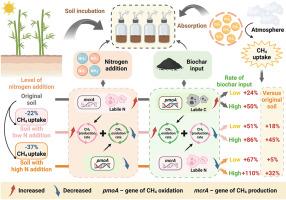在亚热带森林土壤中,生物炭可缓解氮诱导的甲烷吸收抑制
IF 7.7
2区 环境科学与生态学
Q1 ENVIRONMENTAL SCIENCES
引用次数: 0
摘要
森林土壤是大气中重要的甲烷(CH4)汇;然而,来自密集的人为管理和环境大气沉积的外源氮(N)输入通常抑制土壤对CH4的吸收。生物炭的应用被认为是缓解这种抑制的一种潜在策略,但其剂量依赖性、与N输入水平的相互作用以及潜在动力学方面的关键不确定性仍然存在。研究了N添加(0、0.2和0.6 g N kg−1)和生物炭添加(0、5和15 g C kg−1)对森林土壤CH4吸收、土壤理化性质和微生物活性的影响及其相互作用。结果表明,低剂量(0.2 g N kg−1)和高剂量(0.6 g N kg−1)施氮分别使CH4吸收量减少22%和37%,而生物炭添加在低剂量(5 g C kg−1)和高剂量(15 g C kg−1)施氮下分别使CH4吸收量增加24%和50%。高生物炭输入率下,受刺激的CH4吸收增强,高N添加水平进一步放大。在高氮水平下,较大的生物炭输入导致CH4吸收最大,增加了110%。随着氮水平的增加,生物炭增加土壤CH4吸收的途径变得更加多元化。在高氮水平下,生物炭降低了NH4+-N、NO3−-N和水溶性有机氮水平,同时降低了mcrA基因的丰度。此外,生物炭提高了水溶性有机C浓度和pmoA丰度。总的来说,这些变化抑制了CH4的产生速率,同时刺激了CH4的氧化速率,转化为CH4摄取的显著增强。这些发现强调了生物炭通过调节土壤C和N库以及微生物活动,在增加外源氮输入的情况下增强森林土壤CH4固存的潜力。本文章由计算机程序翻译,如有差异,请以英文原文为准。

Nitrogen-induced suppression of methane uptake is alleviated by biochar in a subtropical forest soil
Forest soils serve as an essential atmospheric methane (CH4) sink; however, exogenous nitrogen (N) inputs from intensive anthropogenic management and ambient atmospheric deposition typically suppress the uptake of CH4 by soils. The application of biochar has been proposed as a potential strategy to mitigate this suppression, yet critical uncertainties persist regarding its dose dependency, interactions with N input levels, and underlying kinetics. This study investigated the impacts of N addition (0, 0.2 and 0.6 g N kg−1), biochar amendment (0, 5 and 15 g C kg−1) and their interactions on the CH4 uptake, soil physicochemical properties, and microbial activities of forest soils. The results demonstrated that N addition decreased the CH4 uptake by 22 % and 37 % under low (0.2 g N kg−1) and high (0.6 g N kg−1) applied doses, respectively, while biochar amendment increased the uptake by 24 % and 50 % under low (5 g C kg−1) and high (15 g C kg−1) applied doses, respectively. The stimulated CH4 uptake intensified under higher biochar input rate and was further amplified by greater N addition level. Under high N level, greater biochar input resulted in a maximal CH4 uptake, achieving a 110 % increase. As N levels increased, the pathways through which biochar augments the uptake of soil CH4 became more multifaceted. Specifically, under high N level, biochar inputs reduced NH4+-N, NO3−-N, and water-soluble organic N levels, while lowering the abundance of mcrA gene. Furthermore, biochar increased the water-soluble organic C concentration and the pmoA abundance. Collectively, these changes suppressed the CH4 production rate while stimulating the CH4 oxidation rate, translating to a significant enhancement in CH4 uptake. These findings emphasize the potential of biochar to enhance CH4 sequestration in forest soils with increasing exogenous N inputs through the modulation of soil C and N pools, as well as microbial activities.
求助全文
通过发布文献求助,成功后即可免费获取论文全文。
去求助
来源期刊

Environmental Research
环境科学-公共卫生、环境卫生与职业卫生
CiteScore
12.60
自引率
8.40%
发文量
2480
审稿时长
4.7 months
期刊介绍:
The Environmental Research journal presents a broad range of interdisciplinary research, focused on addressing worldwide environmental concerns and featuring innovative findings. Our publication strives to explore relevant anthropogenic issues across various environmental sectors, showcasing practical applications in real-life settings.
 求助内容:
求助内容: 应助结果提醒方式:
应助结果提醒方式:


